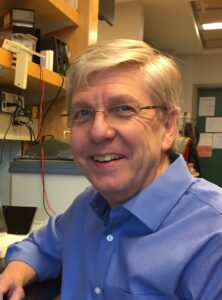 Philip Hieter is an award-winning biochemist currently working at the Michael Smith Laboratories at the University of British Columbia. By using yeast as a model to understand the causes of genome structure and sequence changes underlying tumorigenesis, Hieter has identified genetic vulnerabilities in tumor cells “that could be exploited for therapeutic benefit in the treatment of cancer.” In addition to being elected to the American Academy of Arts and Sciences as well as the National Academy of Sciences, Hieter won the 2018 George W. Beadle Award from the Genetics Society of America for his work facilitating collaboration and community among life sciences.
Philip Hieter is an award-winning biochemist currently working at the Michael Smith Laboratories at the University of British Columbia. By using yeast as a model to understand the causes of genome structure and sequence changes underlying tumorigenesis, Hieter has identified genetic vulnerabilities in tumor cells “that could be exploited for therapeutic benefit in the treatment of cancer.” In addition to being elected to the American Academy of Arts and Sciences as well as the National Academy of Sciences, Hieter won the 2018 George W. Beadle Award from the Genetics Society of America for his work facilitating collaboration and community among life sciences.
Before his accomplished scientific career, Hieter was a doctoral student at Johns Hopkins University and winner of the 1981 CGS/ProQuest Distinguished Dissertation Award. We sat down with Dr. Hieter to learn more about his work and any advice he has for students who want to make the most out of their time in graduate school.
What are you currently working on?
Genome instability distinguishes cancer cells from normal cells and as such can be exploited as a genetic vulnerability to develop therapies that selectively kill cells exhibiting genome instability. Over the past 35 years, my lab has been studying the molecular components required for chromosome transmission in yeast, with the over-arching goal of relating our work in yeast to human cancer. We are currently fascinated by the finding that inhibitors of the cancer drug target, PARP1, cause cytotoxicity in BRCA1 mutated cancer cells, not because of the loss of PARP enzyme activity per se, but rather from the trapping of the PARP protein on DNA that causes a toxic lesion. We have recently developed a yeast-based screening system that exploits point mutations that more accurately mimic the activity of chemical inhibitors that trap their protein target on DNA. We believe this approach will increase the chance that drug targets will translate into effective therapies, and opens a new avenue for target screening that will identify novel therapeutic targets that would be missed by current approaches.
How did your graduate training shape your current career?
My thesis advisor, Phil Leder, was an inspirational, creative scientist and mentor to me, who truly shaped my approach to research, and opened the doors that I was fortunate to have available to me as my career developed as an independent scientist. The Leder laboratory had incorporated all the cutting-edge recombinant DNA technologies of the time (in the late 70’s; bacteriophage lambda DNA library construction, restriction enzymes and plasmid vectors, DNA sequencing), and had them working very efficiently. This suite of technologies enabled us to tackle previously unapproachable problems in antibody gene structure and function. My experience as a graduate student in the Leder laboratory impressed upon me the critical importance of technology development and its implementation in driving research productivity. As a result, technology development has been a major theme in my independent laboratory and a key to the success of my students and postdocs over the years.
What was the most valuable piece of advice that you received in graduate school?
Towards the end of my graduate research work, Phil Leder told me to take time, to explore, talk with people, and try to figure out who I wanted to work with during a postdoctoral fellowship. Phil Leder’s advice was to pick an exciting research area that was taking off, and that complemented my expertise and knowledge, so that I could “connect the dots” in a unique way for whatever next step I would be taking longer term. After much consideration and consultation with colleagues, this led me to Ron Davis’s lab at Stanford, moving from the study of mammalian antibody genes using recombinant DNA technology as a graduate student, to the study of yeast chromosome biology using yeast genetics (including the newly developed methods for DNA transformation and gene replacement in yeast) as a postdoc. The intersection between these diverse approaches turned out to be highly productive, and had a positive impact on my career in the long term.
If you could provide one piece of advice to a current graduate student in your field, what would it be?
Pick an important problem, surround yourself with good colleagues (mentor, lab mates, academic environment, collaborators), and go deep. If possible, include a “horizontal” component to your research in which you develop technology that is broadly applicable to the research community. The “vertical” component will be the application of technology to an important problem to go deep into the biological mechanisms. During your academic journey, be grateful for having the privilege to pursue a research problem as a member of the international community of scientists, and definitely make time for yourself to have fun outside the lab. Work hard, play hard, and remember – sleeping is highly over-rated!
To learn more about Philip Hieter’s work, visit his faculty page on the University of British Columbia website.
